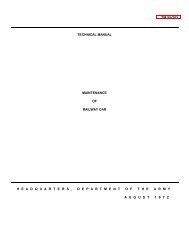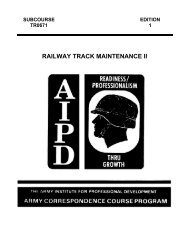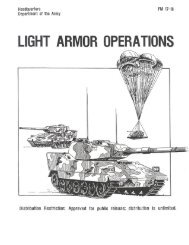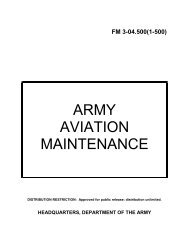AIR DEFENSE ARTILLERY REFERENCE HANDBOOK
AIR DEFENSE ARTILLERY REFERENCE HANDBOOK
AIR DEFENSE ARTILLERY REFERENCE HANDBOOK
You also want an ePaper? Increase the reach of your titles
YUMPU automatically turns print PDFs into web optimized ePapers that Google loves.
FM 44-100-2<br />
2-4<br />
warheads, to include submunitions, allows targeting of both soft and hard<br />
targets. NBC weapons pose the most serious threat, but currently very few<br />
countries have CM with nuclear warheads. However, the development of a<br />
chemical or biological warhead is not difficult. The May 1997 Quadrennial<br />
Defense Review report noted that the use of NBC weapons is a likely<br />
condition of future warfare, and that these weapons could be delivered by<br />
several means including CM. The success of cruise missiles in Operation<br />
Desert Storm led to increased interest in these systems and spurred current<br />
worldwide developments. Threat experts foresee an increase in the number of<br />
LACM within the next ten years, as well as extended ranges, improved<br />
accuracy, reduced RCS, and increased lethality. The addition of smart<br />
submunitions will allow the engagement of armored units on the move in the<br />
near future. Countermeasures and evasive maneuvers are also potential<br />
capabilities. Figure 2-3 illustrates cruise missile characteristics.<br />
Targets<br />
Current Capabilities<br />
• Geopolitical/population centers • Range from 30 to 3000 Km<br />
• Airports and seaports<br />
• Highly accurate<br />
• Logistical areas<br />
• 360-degree threat<br />
• Command and control centers • Very low radar signature<br />
• Troop concentrations<br />
• Air, sea, or ground launched<br />
• Warheads -- all types<br />
Future Trends<br />
• More land attack variants<br />
• Reduced radar signature<br />
• Increased use antiarmor submunitions<br />
• Improved accuracy<br />
Figure 2-3. Characteristics of Cruise Missiles<br />
<strong>AIR</strong>-TO-SURFACE MISSILES<br />
2-8. Air-to-surface missiles (ASM) are air-launched, precision-guided<br />
munitions designed to strike ground targets. They are ideal against targets,<br />
such as bridges, that are difficult to destroy with "dumb" bombs. They are<br />
similar to air-launched CMs, but are smaller, have shorter ranges, lack the<br />
wings and aerodynamic lift associated with CMs, and are launched by<br />
tactical fighter-bomber aircraft. The former Soviet Union and free world<br />
countries widely export ASM, and they are operational in numerous air forces<br />
around the world. What Makes ASM threatening? ASM are an extremely<br />
lethal threat because of their versatility and pinpoint accuracy. Most threat<br />
ASM are of Soviet or Russian origin and employ radio command, laser, antiradiation<br />
homing, or electronic-optical guidance systems.<br />
2-9. Missiles that employ anti-radiation homing systems are referred to as<br />
anti-radiation missiles (ARMs); they represent the greatest threat to air and











